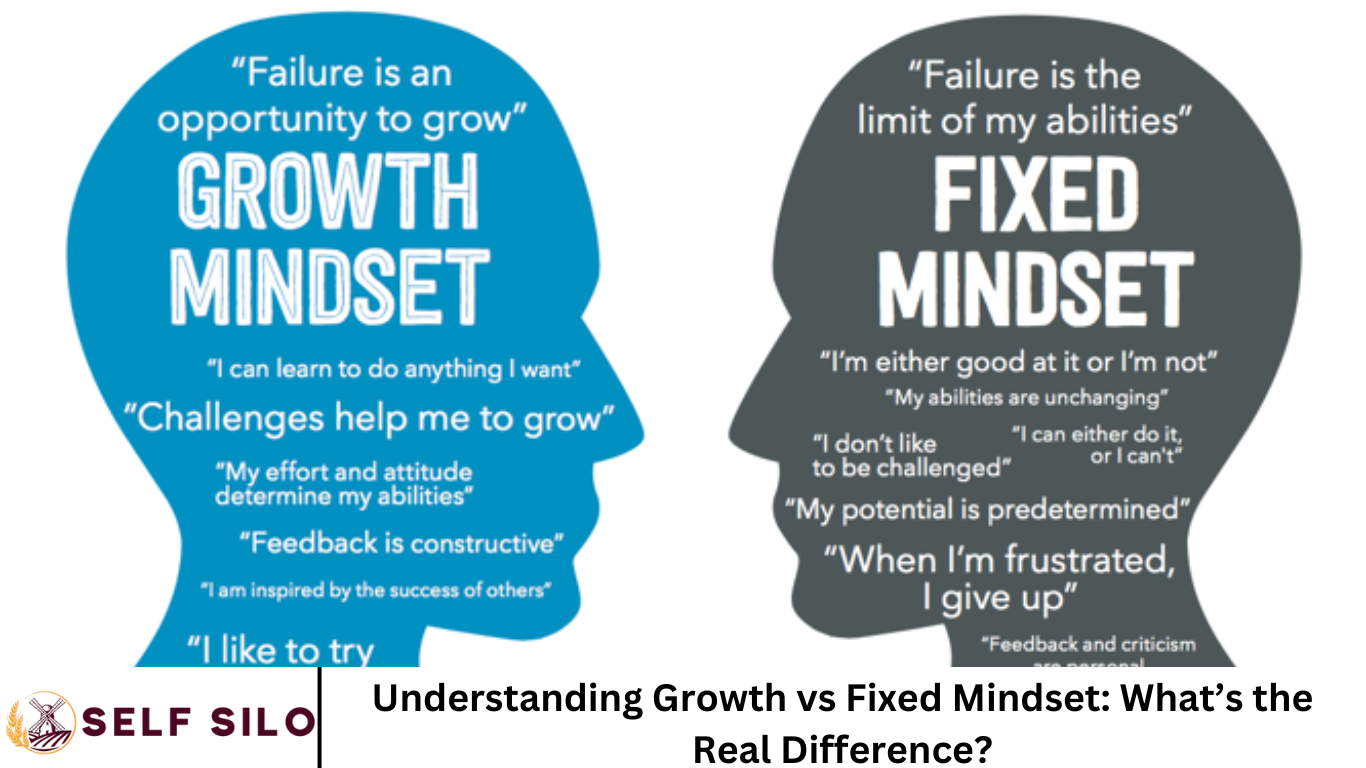Have you ever wondered why some people seem to thrive on challenges while others shy away from them? The answer may lie in something called mindset. Our mindset influences how we perceive our abilities, how we respond to failure, and ultimately, how we grow as individuals.
In this article, we’ll explore the key differences between a growth mindset and a fixed mindset, delve into the psychological origins of these concepts, and discuss how they impact success, learning, and personal development.
More Read: Understanding Motivation: How to Build and Sustain Drive
What is a Mindset?
A mindset is a set of beliefs or attitudes held by someone. It affects how we think, feel, and behave in various situations. Psychologist Carol Dweck, a pioneer in the field of motivation and personality psychology, introduced the concept of growth and fixed mindsets through decades of research. Her work has shown that the way people view their intelligence and abilities can significantly influence their motivation and achievement.
Growth Mindset Explained
A growth mindset is the belief that abilities and intelligence can be developed through dedication, hard work, and learning from mistakes. People with a growth mindset see challenges as opportunities to improve and view failure as a natural part of the learning process.
Key Traits of a Growth Mindset:
- Embraces challenges
- Persists in the face of setbacks
- Sees effort as the path to mastery
- Learns from criticism
- Finds inspiration in others’ success
Someone with a growth mindset might say, “I can’t do this yet, but with practice, I will get better.”
Fixed Mindset Explained
In contrast, a fixed mindset is the belief that intelligence and talents are static traits that cannot be significantly changed. People with a fixed mindset may avoid challenges, give up easily, and feel threatened by the success of others.
Key Traits of a Fixed Mindset:
- Avoids challenges
- Gives up easily
- Sees effort as fruitless
- Ignores useful feedback
- Feels threatened by others’ success
Someone with a fixed mindset might think, “I’m just not good at this, so there’s no point in trying.”
The Science Behind bMindsets
Dweck’s research, particularly her studies with schoolchildren, revealed that mindset plays a crucial role in academic achievement. In one famous study, students were praised either for their intelligence or their effort. Those praised for effort (growth mindset) were more likely to tackle difficult problems, while those praised for intelligence (fixed mindset) were more likely to avoid them.
Neuroscience also supports the concept of a growth mindset. Brain imaging studies show that when individuals believe they can improve, their brain activity reflects a greater readiness to learn and adapt. Neural pathways become stronger with practice, reinforcing the idea that the brain is malleable.
Impact on Learning and Performance
The mindset we adopt can significantly affect our learning strategies, resilience, and performance in both academic and professional settings.
- In Education: Students with a growth mindset tend to perform better because they are more willing to put in effort and try new strategies.
- In the Workplace: Employees with a growth mindset are more likely to seek feedback, pursue development opportunities, and adapt to change.
- In Relationships: A growth mindset fosters better communication, empathy, and conflict resolution skills.
How to Develop a Growth Mindset
Shifting from a fixed to a growth mindset is possible with conscious effort and practice. Here are some practical steps to help cultivate a growth mindset:
- Acknowledge and Embrace Imperfections: Recognize your weaknesses and see them as areas for improvement.
- View Challenges as Opportunities: Approach difficult tasks with curiosity and persistence.
- Replace Negative Self-Talk: Use phrases like “I can learn this” instead of “I’m not good at this.”
- Celebrate Effort, Not Just Results: Value the process of learning, not just the outcome.
- Learn from Criticism: Accept feedback as a tool for growth rather than a personal attack.
- Be Inspired by Others: Let others’ achievements motivate you instead of making you feel inferior.
Real-World Examples of Growth Mindset
- Michael Jordan: Cut from his high school basketball team, he used that setback as motivation to become one of the greatest athletes of all time.
- J.K. Rowling: Faced multiple rejections before finally publishing the Harry Potter series, illustrating the power of perseverance.
- Elon Musk: Continuously learns from failures and uses them to fuel innovation at companies like SpaceX and Tesla.
Challenges in Adopting a Growth Mindset
While the benefits of a growth mindset are clear, adopting one is not always easy. Cultural norms, past experiences, and self-doubt can all reinforce a fixed mindset. Overcoming these obstacles requires self-awareness, support from others, and a willingness to change.
Growth Mindset in Schools and Organizations
Many schools and organizations are now incorporating growth mindset principles into their curricula and training programs. By creating environments that encourage risk-taking, value effort, and provide constructive feedback, these institutions are helping individuals unlock their potential.
- In Schools: Teachers use language that promotes effort and improvement, rather than innate ability.
- In Companies: Managers foster a culture of learning where mistakes are seen as opportunities to grow.
Frequently Asked Question
What is the main difference between a growth mindset and a fixed mindset?
The main difference lies in how people perceive their abilities. A growth mindset believes skills and intelligence can be developed through effort and learning. A fixed mindset believes these traits are innate and unchangeable.
Who introduced the concepts of growth and fixed mindsets?
Psychologist Carol Dweck introduced the terms through her research on motivation, personality, and development. Her book Mindset: The New Psychology of Success popularized the concepts.
Can someone have both mindsets?
Yes. Most people are not entirely one or the other. You might have a growth mindset in one area (like sports) and a fixed mindset in another (like math). The goal is to identify and shift fixed mindset thinking when it arises.
Why is a growth mindset important for success?
A growth mindset encourages resilience, learning from failure, and continuous improvement—all of which are critical for long-term personal and professional success.
How can I develop a growth mindset?
You can develop a growth mindset by embracing challenges, learning from mistakes, replacing negative self-talk with encouraging language, and valuing effort over immediate success.
Do schools and workplaces benefit from promoting a growth mindset?
Absolutely. In schools, it boosts student motivation and performance. In workplaces, it fosters innovation, adaptability, and a culture of continuous learning.
Is a growth mindset always better than a fixed mindset?
Generally, a growth mindset is more beneficial for personal development. However, some researchers argue that blending realistic assessments (from a fixed mindset) with a growth approach can lead to balanced decision-making.
Conclusion
Understanding the difference between a growth mindset and a fixed mindset can be transformative. While a fixed mindset limits potential, a growth mindset opens doors to continuous learning and achievement. By embracing challenges, learning from mistakes, and believing in our ability to grow, we can all unlock our full potential. Remember, changing your mindset doesn’t happen overnight. But with time, reflection, and persistence, anyone can shift from a fixed mindset to one that empowers growth, resilience, and success.


